Abstract
The existence of echoes in an acoustic event can ruin the capture of a spoken message and the perception of a piece of music. Likewise, in the performers’ area, clear hearing is essential for the coordination and execution of the ensemble. Bullrings are buildings with a circular plan in which echo-encouraging focalisations can occur. Since bullrings lack a roof, the density of reflections is lower than that in a closed area, and therefore strong isolated reflections perceived by the audience as an echo can be created. In this work, calculations of the echo parameter (Echo Criterion EK) and inspection of impulse responses and energy decay curves are obtained in an on-site measurement campaign in the audience zones and in arena areas where the EK parameter exceeds the thresholds. To this end, four bullrings very emblematic of the Iberian Peninsula together with a very prominent Roman amphitheatre in a relatively good state of conservation in the Roman province of Hispania comprise the study cases. Experimental results of the EK parameter and from acoustic simulation in two of the bullrings present good concordance and show that there is no echo for music in any of the venues in the spectator zones and that the most critical area is when source and receiver are both in the arena, where even double and triple echoes appear.
1. Introduction
The transmission of sound between two points in a room is formally represented by the impulse response of the transmission path. This impulse response is composed of direct sound and the numerous repetitions of the original sound impulse caused by reflections of the sound signal at the boundaries of the room. With respect to the direct sound, each of these reflections is specified by its level and its time delay. Since our ear is also sensitive to the direction of incidence of sound, this description must be completed by indicating the direction from which each reflection reaches the receiving point. There may be differences in the spectrum, since the various components of the impulse response, strictly speaking, are not exact replicas of the original sound signal due to the frequency-dependent reflection coefficients of the wall faces.
Two subjective effects of the reflected components of sound are known: the first occurring, under certain conditions, when said reflection can become an “echo” that is heard as a signal repeated over time that appears to come, subjectively, from another place than where the sound is located. This effect is due to the numerous acoustic signals delayed in time through a reflection on a surface, which reach the listener with sufficient energy compared to other sounds or reflections. This phenomenon can frequently be observed outdoors with sound reflections off the walls of houses or at the edge of forests. In closed spaces, these experiences are less common, since echoes therein are fortunately usually masked by the reverberation of the room. Whether a reflection will become an echo or not depends on its delay with respect to the direct sound, its relative level, the nature of the sound signal, and the presence of other reflections that eventually mask the reflection in question [1].
The other subjective effect refers to humans’ ability to locate sound sources in closed spaces. Obviously, it is the sound signal that reaches the listener first that subjectively determines the direction from which the sound comes (Cremer, law of the first wave front [2]).
The enormous amount of information that characterises the impulse response must be condensed into certain parameters that summarise the situation in a subjectively meaningful way. This is carried out primarily by comparing the energies contained in the different parts of the impulse response. This procedure is not only an expedient dictated by practical limitations but is also justified by the limited ability of human hearing to distinguish between all the countless repeated sound signals.
A reflection is not subjectively perceived as something separate from direct sound, as long as its delay and relative strength do not exceed certain limits. Its only effect is to make the sound source appear somewhat larger and increase the apparent loudness of the direct sound. Since these “early reflections” support the sound source, they are considered useful.
Reflections that reach the listener with a longer delay are perceived as echoes in unfavourable cases; in favourable cases, they contribute to the reverberation of the room. In principle, any reverberation harms the intelligibility of speech because it blurs its temporal structure and mixes the spectral characteristics of successive phonemes or syllables. Therefore, “late reflections” are considered harmful from the perspective of speech transmission. From our everyday experience with outdoor echoes, but even more precisely from the results of Haas [3] and similar findings, it can be concluded that the critical delay time separating useful reflections from harmful ones lies in the range from 50 to 100 ms.
Typically, early reflections arriving within 50 ms relative to the direct sound improve the signal received by the listener. However, any early reflection that arrives after 50 ms can be perceived as a separate sound, with a disturbing effect. This is called an echo and gives the impression that the sound is repeated. To perceive such an echo, the total distance travelled by the reflected sound must be at least 17 m, which is derived by multiplying the speed of sound by the delay of 50 ms.
It is very unlikely for an echo to occur in a closed room, with a greater probability in positions far from the sound source (lower direct sound) and close to a reflective surface, as verified by Vera-Guarinos et al. [4]. These authors, using a 2D geometric tool (GeoGebra), analyse the reflections of two pairs of parallelepiped walls, where they confirm that the most probable echo risk zone is always the area farthest from the source and closest to the rear wall. As the size of the enclosure increases, and the greatest risk of echo formation occurs in places far from the emitter and close to the reflective rear wall. The same conclusions are obtained when the floor and ceiling are included and analysed with Catt Acoustic. This risk of echo increases when focalisation occurs, such as with concave curved surfaces with cylindrical or elliptical geometry [5,6], as found in bullrings and Roman amphitheatres [7]. Likewise, in an architectural space without a roof, the density of reflections is lower, and Rindel [8] points out that the existence of echoes is therefore more possible.
Based on the findings of Haas, a criterion was proposed by Bolt and Doak [9], represented by constant percentage disturbance contours of the amplitude of reflections as a function of delay time relative to the direct sound.
Furthermore, Dietsch and Kraak [10] have proposed an echo detection criterion based on the time of the centre of gravity of the impulse response. The criteria have been investigated for both speech and music. It is assumed that the two opposing physical magnitudes of the delayed reflection, the sound pressure amplitude p and the delay time t, are linked by being a constant product with the acoustic pressure with an exponent n or weighting factor to be determined. One objective criterion for room acoustics that adequately links both physical magnitudes is the centre of gravity time.
The centre of gravity time of an impulse response (p(t)) normalised to its total energy is
where n = 2 for the traditional centre time formula, and τ = ∞ in the upper limit of the integral, Kürer [11]. For this criterion, a suitable value of n was found to be n = 2/3 for speech and n = 1 for music.
Lastly, the echo criterion (Echo Criterion EK) is expressed by the relationship between the time of the strong reflection τ and the temporal duration of the reflection Δτ as
For speech, n = 2/3 and Δτ = 9 ms. For music, n = 1 and Δτ = 14 ms.
A disturbing echo for speech appears if EK exceeds a critical value of 1 at a time delay of s > 50 ms, then there is a 50% chance that a listener will detect a disturbing echo for the spoken word. If EK exceeds a critical value of 1.8 at a time delay of s > 80 ms, then there is a 50% chance that a listener will detect a disturbing echo for light music, while with “heavy” or “dense” music, this value is definitely higher. The maximum value of EK(s) after 50 or 80 ms is the Dietsch echo parameter for speech and music, respectively. Table 1 summarises all the information presented.

Table 1.
Echo thresholds for EK by Dietsch and Kraak.
Through simulated and auralised impulsive responses to music and speech, listening tests are audited in order to indicate the existence of strong echoes and reflections in concert halls and auditoriums. In this way, Lovstad [12] prepares suitable sets of impulsive responses generated by Odeon with a simple echo and three successive echoes for the spoken word as well as several pieces with various musical instruments and examines the correlation between the results of the tests and the objective criteria established based on the impulsive responses generated. Said author uses a 50 ms long Hann filter to convolve the Hann window with the energy of the impulse response by analysing its peaks in relation to the reverberation decay, and finds a good correspondence between the calculated values of the new criterion and the results of the listening tests.
Furthermore, Wargert [13], in order to study strong reflections that can be perceived as echoes, proposes two parameters obtained from the impulse response of a room (RIR): the slope ratio, which is the instantaneous slope of the energy decay curve, normalised with its average slope. This parameter is defined by Jeong et al. [14] to indicate when an impulse response has become diffuse. In this context the instantaneous slope corresponds to the individual behaviour of the reflection of interest, while the average expected behaviour of the adjacent reflections is represented by the average slope. The other parameter that completes the description of reflection in the impulse response is the total energy drop at the time of strong reflection, ΔEDC. This author employs these two proposed parameters and the EK proposed by Dietsch and Kraak according to the results of listening tests of virtual impulse responses for different volumes, delay times, and reverberation times. The results show that ΔEDC is a good parameter for detecting strong reflections that can be perceived as an echo.
Although the bullfighting spectacle is visual, the dialogue, cheers, applause, silences, and musical interpretations of bugle and timpani, trumpets (Lisbon), and marching bands are essential for each space and its idiosyncrasies to be understood. In this work, the EK parameter is studied in the receivers in the public area in four bullrings and in a Roman amphitheatre, since spaces without roofs run the risk of the presence of echoes [8]. Another important facet of the problem related to echoes involves the experience of the interpreters themselves. For an orchestra to collaborate successfully, musicians need to hear themselves and their colleagues clearly. Accordingly, this study has also studied positions in which both the source and the receiver are in the ring or in the arena of the Roman amphitheatre. In particular, this acoustic phenomenon has also been studied in a covered bullring with a mobile roof, since several authors point out a case in a covered bullring in Spain where a flutter echo clearly appears in the ring [4,15]. Although this parameter, EK, is not found in the ISO standard, its ability to predict echoes is widely accepted, and is included in the best software applications that deal with the measurement of room acoustics.
2. Methods
Measurements are carried out without the presence of an audience and following the recommendations of the ISO 3382 standard [16,17], while ensuring that the required background noise levels and signal-to-noise ratio (SNR) are maintained. There is no wind during the measurement times (air speed less than 0.5 m/s) and environmental conditions are monitored by measuring the temperature with a precision of ±1 °C and a relative humidity precision of ±5%. The on-site measurements are carried out with the following equipment.
The signal generation, acquisition, and analysis process has been carried out with the IRIS software package [18], and through the MOTU 4PRE HYBRID sound card. The excitation signal is a sweep of sinusoidal signals with a duration of 30 s and a frequency range of 20 Hz to 20,000 Hz. This excitation signal is reproduced in the space using a DD5 García Calderón ultralight dodecahedral omnidirectional sound source located at 1.50 m above the ground, previously amplified with a B&K 2734-type power amplifier. The impulse responses (IRs) are captured with the Core Sound TetraMic microphone array pointing towards the sound source as recommended by the manufacturer, thereby enabling the incorporation of temporal and spatial (3D) information.
In all cases studied, the microphone is placed 1.20 m from the ground, except in the receivers in the passageway that are located 1.60 m from the ground [19,20]. The EK echo parameters have been obtained through the WAV signals of the bullrings loaded into EASERA software v.1.2 [21], since the IRIS platform fails to provide this parameter.
3. Materials
This section briefly describes the spaces studied and where the receivers and the sound source are located: three open bullrings (Real Maestranza de Caballería de Ronda (Malaga), Real Maestranza de Caballería de Sevilla, and Las Ventas de Madrid, all in Spain); a fourth with a mobile roof measured with the roof closed and again with a segment of the roof open (Campo Pequeno de Lisboa, Portugal); and a Roman amphitheatre (Anfiteatro Romano de Itálica, Santiponce, Seville, Spain). The enclosures are described in the same order in which the acoustic measurements are carried out. The multi-source nature of the bullfighting spectacle makes it advisable to have a good number of source–receiver combinations to understand its sound field. The choice of sound-source positions is based on the locations of natural sound sources in bullfighting. The centre and side of the ring, S1 and S2 respectively, where most of the bullfighting takes place, are associated with the voice of the bullfighter, picador, and the other bullfighter assistants. The source position of a musical nature, S3, is associated with the box of the music band, while that of musical instruments, S4, is located where a change in the stage of the bullfight is announced: with bugle, and timpani calls in Spain, and with trumpet calls in Portugal. Lastly, for the ambient sound of the public, the S5 (voice) is positioned in a significant segment of each bullring. In Ronda, with only 4 sound-source positions, S4 is the ambient sound, and in Lisbon the S5 position has not been studied due to timing problems. More details can be found regarding this issue in Martín-Castizo et al. [19,20]. For the Roman amphitheatre of Italica, the three positions of the sound source are for speech and music.
3.1. The Bullring of the Real Maestranza de Caballería de Ronda
The Royal Maestranza de Caballería of Ronda (RMCR), created in the 16th century for the defence of the city and its territory, is today a non-profit charitable organisation dedicated to cultural promotion and the teaching of horsemanship [22]. Among its assets, the bullring stands out; located within the historical centre of Ronda, it is one of the oldest in Spain and was declared a Site of Cultural Interest in 1993 in the monument category.
Construction on the building began in 1780, and after a temporary suspension, it was completed in 1785. The building was designed by architect Martín de Aldehuela. The nobility of its architectural design, with its double arcade and the absence of open grandstands, has more the spirit of a cloister than a performance venue and is reminiscent of the circular courtyard of the famous Palace of Charles V in the Alhambra in Granada. Its 66-metre-diameter arena is considered the widest in the world and is surrounded by a passageway formed by two stone rings. The continuous galleries have five rows of two-storey stands, with 136 columns forming 68 Tuscan column arches. Except for the Royal Box, covered with a gabled Arabic tile roof, the elegance of its interior remains unmatched by any other bullring worldwide.
The current capacity of the bullring is approximately 4890 spectators (Figure 1).
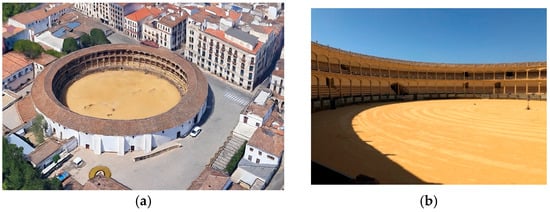
Figure 1.
(a) Aerial view of the Ronda bullring (Source: Google Earth). (b) Interior view of the bullring showing the acoustic source in the centre of the ring (Source: Authors’ own).
Figure 2 depicts the four sound-source positions studied in this bullring. Table 2 shows the 48 source–receiver combinations that have been recorded, including those combinations that lack direct sound depending on the positions of the sound sources, which often happens in certain stands when the sound sources are out of sight of the spectator.
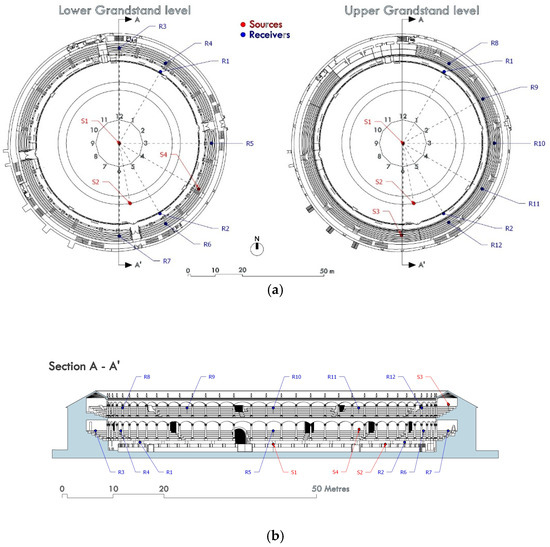
Figure 2.
(a) Section and (b) floor plans of the bullring of Ronda showing the 4 sound sources and 12 receiver positions.

Table 2.
Source–receiver combinations measured in the Bullring of Ronda. (x) Receivers with direct sound. (o) Receivers without direct sound.
In this bullring, due to the columns of the arches of the galleries, there are 9 receivers without direct sound, as can be observed in Table 2. The 48 combinations have only been employed to determine the reverberation times; for the rest of the acoustic parameters, including the EK parameter of Dietsch and Kraak, only the 39 combinations with direct sound are considered.
3.2. The Bullring of the Real Maestranza de Caballería de Sevilla
The architecture of the bullring of Seville describes, both externally and internally, the shape of an irregular polygon, consisting of 30 unequal sides. The external appearance is in the Late Baroque style, pointing to Neoclassicism, in which the Puerta del Príncipe predominates, flanked by two towers, in contrast to the rest of the façade, which is mostly whitewashed. The ovoid-shaped arena, a product of the multiple historical vicissitudes suffered by the architectural complex, is known for its vast surface area, with diameters ranging between 63.2 and 57.9 metres, and for its albero sand, a yellowish-ochre soil that contributes to its luminosity which makes it unique. Its arena is not flat, but slightly conical (Figure 3).
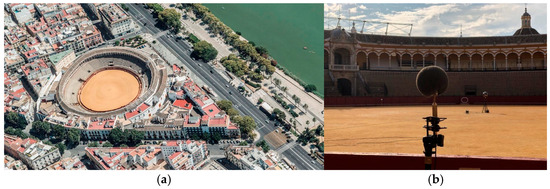
Figure 3.
(a) Aerial view of the Seville bullring (Source: Carbajal Studio with permission http://www.estudiocarbajal.com/en/our-project-for-holiday-apartments-in-calle-adriano-in-diario-de-sevilla/ (accessed on 29 May 2025)). (b) Interior view of the bullring of Seville, with the sound source in position S1 and the Core Sound TetraMic microphone in the passageway (Source: Authors’ own).
The bullring of the Real Maestranza de Caballería of Seville stands out precisely for not being perfectly circular (Figure 3), since, during its prolonged construction from 1740 to 1881, it was forced to adjust to the surrounding dwellings and resembles a large house where the bullring is the central courtyard. With a total capacity of 11,500 seats, the public is accommodated in two areas: 12 segments of stalls, and grandstands. Above this seating area, there is an archway with an irregular layout, like the arena, with marble columns, protected with gabled Arabic tile roofs [23]. These are made up of 117 numbered arches, plus the richly ornate Royal box.
Figure 4 displays the floor plan of the bullring, which shows the positions of the source and receivers, together with its section. In all the 75 source–receiver combinations that have been utilised to record the impulse responses, there is direct sound.
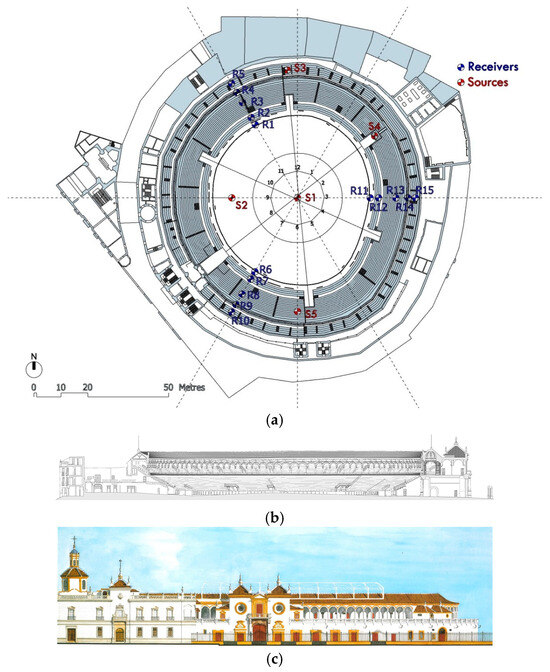
Figure 4.
(a) Floor plan of the Seville bullring showing the positions of the sound source (S) and receptors (R) (Source: Authors’ own); (b) Section of the bullring (Source: Carbajal Studio with permission, http://www.estudiocarbajal.com/en/refurbishment-works-of-real-maestranza-bullring/ (accessed on 29 May 2025)); (c) General elevation from Paseo Colón (Source: Miguel Molina Castillo. University of Seville. School of Architecture. Chair of Analysis of Architectural Forms).
3.3. Las Ventas Bullring
This bullring was designed with the intention of building a monument on the same scale as that of the city, and hence the volume, the portal, and the antechamber of the bullring take on truly significant dimensions [24]. Construction began in 1919 (architect José Espelius Anduaga) and was completed in 1931 (architect Manuel Muñoz Monasterio) (Figure 5a).
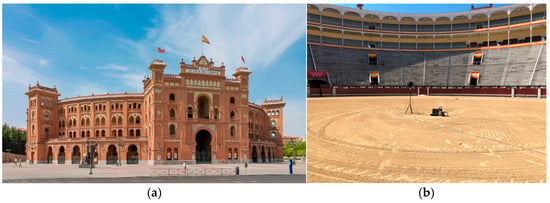
Figure 5.
(a) Exterior view of the Plaza de las Ventas in Madrid (Source: De Luis García, CC BY-SA 3.0, https://commons.wikimedia.org/w/index.php?curid=147129262Wikipedia (accessed on 14 May 2025)). (b) View of the bullring with the sound source in position S1 and of Segments 8 and 9, the stalls and grandstands (Source: Authors’ own).
This constitutes the largest bullring in Spain, built in the Neo-Mudéjar style and with a capacity for 23,798 spectators. It is the third largest bullring in the world, after those of Mexico City (CDMX, Mexico) and Valencia (Carabobo, Venezuela). It is also the second largest in Spain in terms of ring diameter, at 61.5 m, after the Ronda bullring (Malaga, Spain) [25].
This bullring has four floors of circular galleries and five projecting turrets on its exterior façade. It is distributed across ten stands (four shaded stands, numbered 1, 2, 9, and 10; two stands in partially direct sunlight and shaded areas, numbered 3 and 8; and four stands in direct sunlight, numbered 4, 5, 6, and 7). The Presidential boxes, those of the royal family, and other authorities, are located to the east, in a central place of the shaded stands. In turn, the segments are divided by height into stalls, boxes, lower grandstands, and upper grandstands (Figure 5b).
In this bullring, 71 source–receiver combinations have been recorded, all of which have direct sound corresponding to 5 positions of the sound source and 20 receivers (for certain sound sources, not all the receivers have provided measurements in accordance with the authors’ recommendations [19,20]), and 6 more combinations with the sound source and receivers both in the ring (Figure 6).
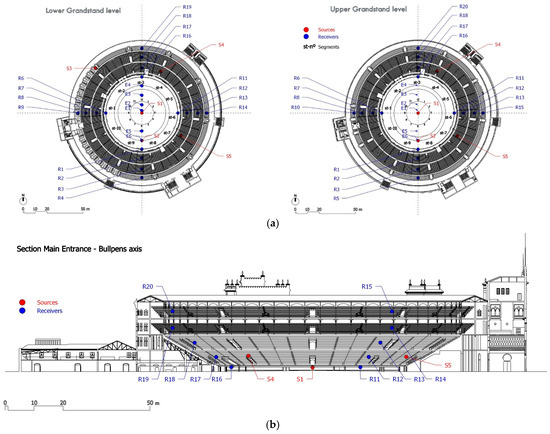
Figure 6.
Positions of the sound source (S) and receivers (R) in Las Ventas bullring in Madrid; (a) stalls and grandstands; (b) section.
3.4. Campo Pequeno Bullring
The Campo Pequeno bullring (in Portuguese) in Lisbon began its construction in 1889 in the Neo-Mudejar style by the Portuguese architect António José Dias da Silva and was completed in 1892. It had a capacity of 8500 people before the 2000 renovation; its current capacity is 6698 seated spectators. The architect was inspired by the old (now demolished) Madrid bullring built by Emilio Rodríguez Ayuso (Figure 7).
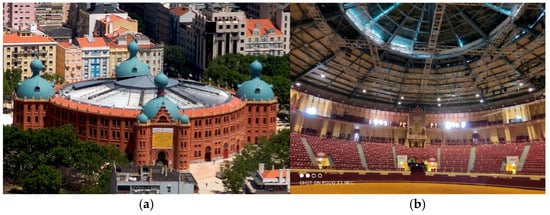
Figure 7.
(a) Aerial photograph of the renovated bullring of Campo Pequeno in Lisbon (Source: https://en.wikipedia.org/wiki/File:Campo_Pequeno.jpg (accessed on 9 May 2025)). (b) Interior view of the Campo Pequeno bullring, showing the Presidential box and Sector 2, Sector 1 even and odd, and Sector 7 (Source: Authors’ own).
This new bullring was built from solid red exposed brick and underwent extensive renovation in 2000, whereby the brick was replaced with reinforced concrete. A shopping arcade was created in the basement, along with other similar spaces at street level (José Bruchy, Pedro Fidalgo, Filomena Vicente, and Lourenço Vicente). The greatest architectural alteration has been the installation of a mobile roof (João Goes Ferreira) that enables it to host various activities throughout the year (Figure 8).
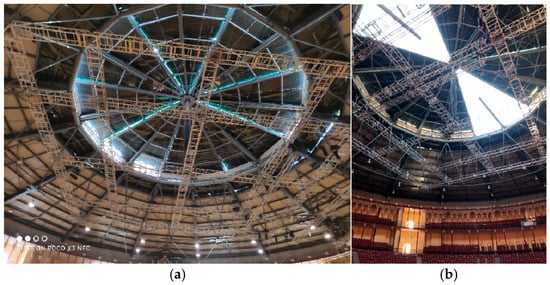
Figure 8.
View of the oculus of the roof of the Campo Pequeno bullring: (a) with the oculus closed; and (b) with the oculus partially open (Source: Authors’ own).
The diameter of its arena is 36.4 m, and the stalls are distributed into 7 sectors: the North half (1 even, 7, 6, and 5) and the South half (1 odd, 2, 3, 4 odd, and 4 even). The plaza is distributed from bottom to top into 14 rows of stalls (letters C-P), boxes (on two levels), and galleries (on two levels) (Figure 9).
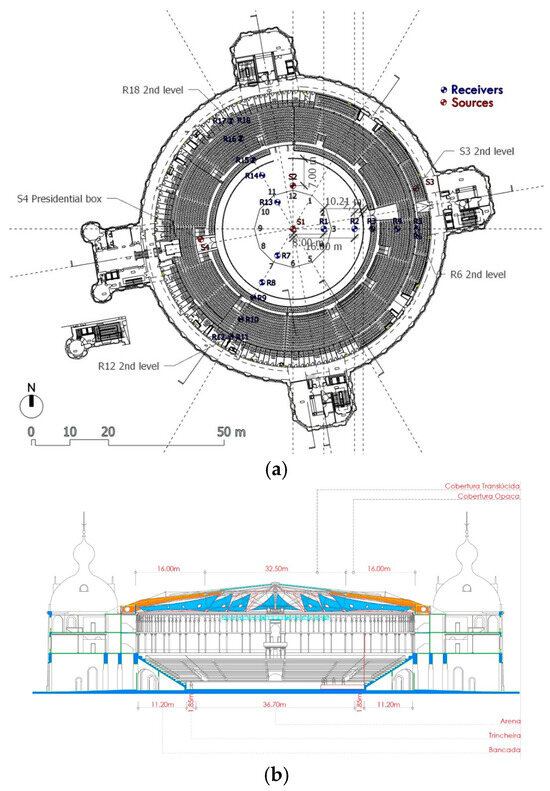
Figure 9.
The bullring of Campo Pequeno: (a) location of sound sources (S) and receivers (R) in the ring, stalls, boxes, and grandstands; (b) section (Source: Plateia Colossal with permission).
Figure 9 shows the 108 source–receiver combinations corresponding to 4 positions of the sound source and 18 receivers with the roof oculus closed, and 2 positions of the sound source and 18 receivers with the roof oculus partially open. Of these measured combinations, 24 correspond to both the sound source and receiver located in the ring that have been used. Only in one combination, S3-R5, is there no direct sound.
3.5. The Italica Amphitheatre
The case study of the Roman amphitheatre of Italica (Figure 10) takes place as a type of precursor to the modern bullring and represents a connection to the theoretical perspective of the acoustics of performances held in the ancient buildings of theatres and circuses, studied by the authors of this work [26]. The modern conception of the circular bullring in the 18th century retains many influences from the ancient amphitheatres: “the arena becomes a ring”. Regarding the time of its construction, there is a general agreement of opinions that advocate the Hadrianic period, approximately between the years 117 and 138, although of unknown architect; like most Roman constructions, given the magnitude, it is thought that several architects intervened therein. Its original appearance would have been that of a great structure of opus caementicium covered with marble slabs and stone from Tarifa. Its seating would have consisted of a podium and three caveas (ima, media, and summa), with a distribution of the amphitheatre tiers on three equal surfaces (podium and ima, media, and summa), the first two tiers of which are still in existence today.
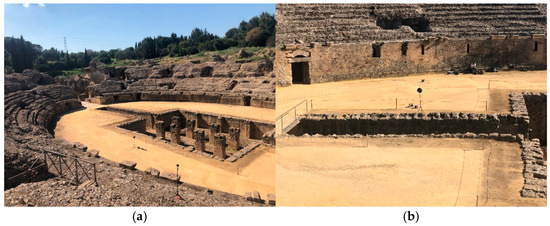
Figure 10.
View of the Italica amphitheatre during the acoustic measurements: (a) sound source in position S2 and microphone in position R14; (b) sound source in position S3 (Source: Authors’ own).
Likewise, in the centre of the arena is the fossa bestiaria (animal pit), originally covered by a wooden platform supported by the eight brick pillars that still remain. In Hispania, the construction of the stands often took advantage of the characteristics of the rocky hills with regard to seating. In the case of Italica, the perfect example of this type of layout is found, built between two hills upon which the stands rest, with the longitudinal axis located in the intervening valley. In this way, the building’s distribution axes (E-W) are formed, which correspond to the main entrances to the arena: the Porta Triumphalis (to the east), through which the gladiatorial retinue entered; and the Porta Libitinensis (to the west), through which the victims of the combat were carried. The latter is in a better state of preservation and reveals the beginnings of the superposition of classical orders.
Regarding the capacity, this is estimated to have been approximately 35,000 spectators, which supports the hypothesis that this building was designed not only for the enjoyment of the Italians themselves, but also for a military garrison that possibly existed in the city, and for the inhabitants of nearby towns. As for the use of the amphitheatre, it is known that the spectacle buildings of the most prominent cities of Hispania were in use throughout the 4th century AD. In fact, several inscriptions found in various areas of the podium include the names of individuals whose seats were reserved: these inscriptions date back to the 4th and 5th centuries AD. It is therefore legitimate to affirm that this building remained in use throughout the 4th century AD. The Italica amphitheatre is the largest of its kind built in Hispania (dimensions: 156 × 134 m) and constitutes the largest in terms of capacity outside the Italian Peninsula. It is surpassed only by the Colosseum in Rome, the Capua amphitheatre, and the Puteoli amphitheatre (modern name, Pozzuoli). This is one of the most complex and ambitious projects of Roman architecture on the Iberian Peninsula.
Figure 11 and Table 3 show the 49 source–receiver combinations used in this space. In the Roman amphitheatre of Italica, the 3 positions of the sound source and the 17 receivers took into account that its arena was designed as an oval in which the relationship between its 4 foci forms a Pythagorean triangle with a ratio of 3:4:5. Therefore, these sources were selected near the foci due to the presence of the fossa bestiaria, and to certain alignments on which the curves corresponding to the four sectors of the oval were drawn.
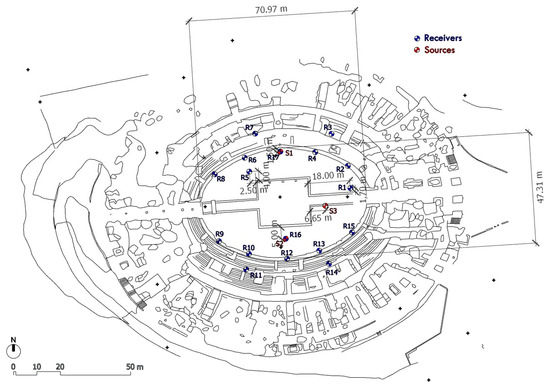
Figure 11.
Floor plan of the Italica amphitheatre in Seville, showing the sound sources (S) and the receptors (R) in the cavea and the arena. (+) Topographic references.

Table 3.
Source–receiver combinations measured in the Italica amphitheatre.
4. Results and Discussion
This section presents the results and analyses of the reverberation and the echo criterion, together with other acoustic parameters related to the intelligibility of the studied spaces.
4.1. Reverberation Times
Reverberation time is the main parameter describing the acoustics of a room. In closed enclosures, its value does not vary practically with distance, but in open enclosures, it can vary and present non-linear energy decay curves [7,8,20,22]; for this reason, a detailed study of its behaviour is presented.
Table 4 shows the spatial average results of the T30 reverberation times in the spaces studied, for the sound source S1 and for all sound sources at 1000 Hz, and for S1 and all sound sources with the average of 500 and 1000 Hz octave bands.

Table 4.
Reverberation time T30 (s) in the bullfighting arenas.
Table 4 highlights the longest reverberation time values in the Las Ventas and Campo Pequeno bullrings, the former due to its large size and the latter because it has a roof. Regarding the latter, there is very little difference between the T30 values with the oculus closed (CO) and partially open (PO). In the Ronda and Seville bullrings, the reverberation time values are similar, although slightly longer in Seville. The shortest T30 values correspond to the Italica amphitheatre and are of the same order of magnitude as in the Segobriga amphitheatre [7]: T30mid for the sound source at the centre of the conic is 1.3 s.
All recorded impulse responses show an impulse response-to-noise ratio, INR > 45 dB in each octave band. The behaviour of the energy decay curves is fundamentally of two types: cliff and plateau [27]. In the first case, the abrupt decrease occurs in the first 5 decibels of the decay, which enables linear drops for the calculation of T30 to be obtained, and justifies the high percentage of IRs in accordance with the standard. The linearity of the energy decay curves has been evaluated by using the degree of curvature C, and the degree of non-linearity ξ for the T30 parameter, defined in Annex B of the ISO 3382-2 standard [17].
In the Ronda bullring, 74.7% of the 288 values (48 source–receiver combinations and 6 octave bands) meet the linearity criteria of 0–5% and 0–5‰, respectively, for both parameters. Moreover, 8.7% of the values exceed the linearity threshold, set at 10% for C and 10‰ for ξ, which renders the T30 results corresponding to these decay curves as questionable. The most notable non-linearity occurs in the extreme bands of 125 and 4000 Hz.
In the Seville bullring, the linearity of the decay curves is determined by the results obtained from 450 recordings (15 reception points, 6 octave bands, and 5 sound-source positions), showing that 66.8% meet the linearity criterion C of 0–5% and ξT30 of 0–5‰; 17.6% fall within the range of doubtful values C of 5–10% and ξT30 of 5–10‰; and 15.6% fail to comply with the linearity criterion C > 10% and ξT30 > 10‰.
In the Madrid bullring, the results show that the criteria established in the ISO standard are met in 87.2% of the combinations (71 source–receiver combinations for 6 octave bands). In no case are both criteria violated simultaneously at all frequencies. Of the 12.8% that fail to comply, 10.1% correspond to ξ violations, with the greatest contribution in the extreme bands of 125 and 4000 Hz. The most notable non-linearity occurs when the sound source is in position S2 at all frequencies for receivers R1 to R5, and for low and high frequencies in receivers R16 to R18 (all these receivers with the sound source on the same radial axis). For receivers R1 to R5, this is due to the proximity of the barrier, which decreases (compared to other sound-source positions) the number of early and late reflections. For receivers R16 to R18, it is due to late-energy focusing.
In the Lisbon bullring, it is found that of the 642 recordings (18 reception points, 6 octave bands, 6 sound-source positions, in the two configurations of the bullring roof), 90.8% meet the linearity criterion C of 0–5% and ξT30 of 0–5‰; 6.5% fall within the range of doubtful values C of 5–10% and ξT30 of 5–10‰; and 2.7% fail to meet the linearity criterion C > 10% and ξT30 > 10‰.
In the Roman amphitheatre of Italica, it is obtained that of the 294 recordings (16 reception points, 6 octave bands, 2 sound-source positions of S1 and S2, plus 17 reception points, 6 octave bands corresponding to S3), 71.6% fail to verify the linearity criterion C > 10% and ξT30 > 10‰; 5.3% are in the range of doubtful values C of 5–10% and ξT30 of 5–10‰; and 23.1% verify the linearity criterion, C of 0–5% and ξT30 of 0–5‰. This lack of linearity in Roman amphitheatres seems to be a common feature, since in the Roman performance spaces of Segobriga [7], while in the Roman theatre, all the curves verify the conditions of linearity, and in the amphitheatre of Segobriga, the linearity, although scarce, depends on the position of the sound source presenting the best conditions when it is located in the centre of the conic. In the Italica amphitheatre, no improvement of the conditions of linearity is observed with the position of the sound source and it cannot be measured in the centre of the conic due to the fossa bestiaria.
4.2. Echo Criterion EK in the Study Cases
Figure 12 shows the statistical data for the results of the echo criterion parameter (EK) for speech and music in the cases studied. For these calculations, the voice-source positions indicated in Section 3 and receivers in the audience area (segments of stalls, grandstands, boxes, etc.) are considered, as are those for the sound source of a musical nature and receivers in the audience area. From this figure it can be observed that, in the Ronda and Lisbon P (partially open oculus) configurations, all the sample data lie below the critical threshold, and for Seville, Madrid, and Lisbon C (closed oculus), the upper limit of 99% confidence interval is below or near the critical threshold. Only in the Italica amphitheatre do the data exceed this limit. Figure 12a also shows the similarity of the results in the Lisbon bullring in the two roof configurations. As for the EK for music, all the results, even for the Italica amphitheatre, are below the echo risk threshold, and, in the case of the bullrings, the results are far below this echo risk threshold. While these data indicate how these spaces behave with respect to echo problems in the spectator area, it remains necessary to analyse the timing of these strong reflections and their connection to impulse responses; this is carried out in the following sections.
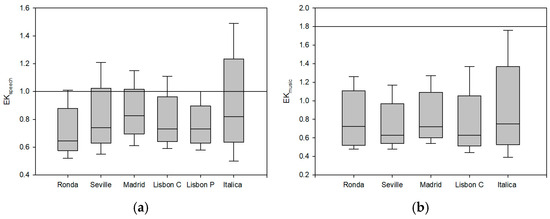
Figure 12.
EK parameters in the venues studied: (a) EK for speech, and (b) EK for music. The box plot shows the median, the 99% confidence interval, and the min and max values of the parameter in the sample. The values of the echo thresholds for each EK provided by Dietsch and Kraak are also shown.
Henceforward, explanations will be given for those receivers where EK exceeds or coincides with the values of 1 and 1.8 for speech and music, respectively, in accordance with Table 1. The tables below show these values for each space studied and the time in ms of the reflection of the impulse response that gives rise to that EK value. The EASERA software provides the EK speech and EK music values, as well as the timings at which these values occur relative to the sound-source emission time, and therefore, EASERA does not correct the time of flight of direct sound. In the following tables, the times of flight of direct sound are corrected. Likewise, regarding the results of the sound source where musical sources are located in the bullrings (music band, bugle calls and timpani, and trumpets), if, at the corresponding reception points, there is no risk of a disturbing echo for music, then these receivers are not subsequently analysed in depth. In all the tables below, the numerical data for EKspeech and Tspeech of the strong reflection that is interpreted as echo after the analysis are shown in bold. Furthermore, the source–receiver distance dS-r, and the intelligibility parameters D50m, TSm (averaged at 500 and 1000 Hz), and STI in the receptor are shown, together with the parameter ratings based on the work by Fürjes and Nagy [28].
4.2.1. Results in the Bullring of Ronda
The discussion is limited to the reception points where, for speech and music, EK exceeds or coincides with the values of 1 and 1.8, respectively, in accordance with Table 1. It can be observed that of the 39 source–receiver combinations in the Ronda bullring, there are only 4 combinations where, in a first approximation, there is a risk of echo for speech: for the sound source S3 in receivers R5 and R8; and for the sound source S4 in receivers R3 and R5, all located in the audience area. Table 5 summarises this information and describes their source–receiver distance and other speech intelligibility parameters for these receivers. In all four combinations, the EK values for speech are on the threshold level, and there is no risk of echo for music in any thereof. However, an inspection of the impulse responses of S3-R5, S4-R3, and S4-R5 and the times at which these strong reflections occur indicate that they are heavily delayed disturbances due to background noise and do not correspond to real echoes. Furthermore, since the S3 sound source is designed for musical use, it can be stated that no echoes are detected at the measurement points.

Table 5.
Echo and other acoustic parameters in the Ronda bullring in the audience area. In bold interpreted as an echo.
According to the intelligibility parameters, intelligibility is considered Fair at various distances in the bullring, and Good at shorter distances. Discrepancies arise between the D50m and STI results, since, according to Onaga et al. [29], the STI does not distinguish useful early energy from non-early energy, which does not contribute to intelligibility.
In the digital acoustic model implemented in this bullring [22], using the room acoustics software ODEON [30], none of the 39 source–receiver combinations in the spectator area show echoes for speech when there is no audience present, in agreement with the findings in the in situ measurements. However, with the audience area 100% full of people, there is a risk of echo according to the EKspeech parameter for the sound source in S1 of the 11 combinations studied (see Table 2) in 6 receivers (R3, R4, R6, R7, R8, and R10) and the values are very close to the EKspeech value threshold of 1 in the remaining 5 receivers. For sound sources S2 and S3, there is no risk of echo in any of the associated receivers, while for S4, for the nine associated receivers (Table 2), there is a risk of echo for speech in two (R7 and R8).
Furthermore, in this model, the acoustic simulation via ODEON has allowed the creation of the EKspeech colour maps of the Ronda bullring shown in Figure 12 for three sound-source positions (S3 music sound-source excluded) without spectators (left-hand side) and with spectators (right-hand side).
Although in all cases the colour pattern without spectators is similar to that with a full capacity of spectators in the galleries, it is observed that, with the source in the centre of the bullring S1, and due to the focusing of the sound from the barrier and grandstands, a distribution of high values of the EKspeech > 1 is observed in the bullring, with even greater values of the parameter observed with 100% capacity in the galleries. For the sound sources in positions S2 and S4, the EKspeech values are more evenly spread out when there are no spectators compared to when the bullring is at full capacity since more areas at risk of echo appear. These areas may even extend into the grandstands, as also mentioned in the previous paragraph according to the simulation in the on-site receivers studied, especially regarding the positions of the sources S3 and S4. In the case of S2, it seems that, in the ring in only a small part of the axis that passes through S2, there is a risk of echo for speech with a slightly larger echo area near the barrier with an audience present (Figure 13d) than with no audience (Figure 13c). With S4 source (public), there are slightly more echo areas in the ring with an audience than with no audience. This last observation also appears in the experimental results of Table 5 and in the numerical data for the aforementioned simulation in the receivers.
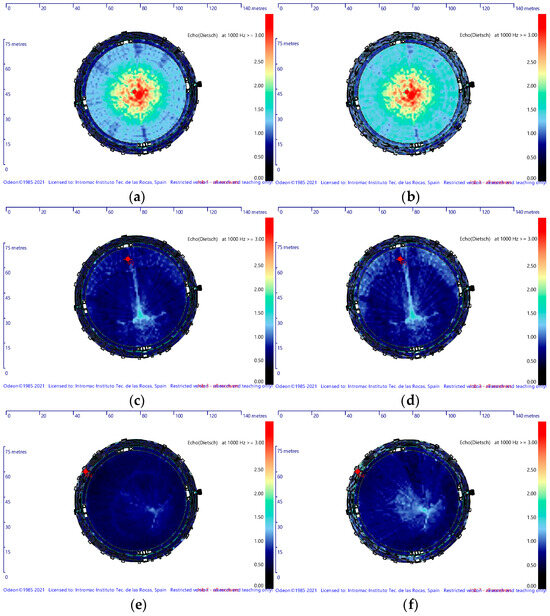
Figure 13.
Maps of the EK speech parameter across the Ronda bullring, corresponding to the three source positions used for speech: (a) S1 without spectators; (b) S1 with spectators; (c) S2 without spectators; (d) S2 with spectators; (e) S4 without spectators; (f) S4 with spectators. In all cases, “with spectators” means that the audience area is completely full.
4.2.2. Results in the Bullring of Seville
In the Seville bullring, of the 75 combinations studied, there is apparently a risk of echo for speech according to the EKspeech values in 8 combinations: in S2-R1, S2-R2, and S2-R10; in S3-R1; in S4-R13 and S4-R14; and in S5-R8 and S5-R13, all located within the audience area. Table 6 describes the echo and other acoustic parameters of these receivers at risk of echo. However, an inspection of the impulse responses of these combinations and according to the times at which the strong reflections occur, only in the S5-R13 combination does a significant reflection with respect to direct sound occur, with a risk of echo for speech. In the other cases, these are heavily delayed disturbances due to background noise, and they do not correspond to real echoes. Furthermore, in many cases, the value above the threshold is for echo for speech, and these are source positions where musical sources are arranged (S3 and S4), in none of which is there a risk of echo for music.

Table 6.
Echo and other acoustic parameters in the Seville bullring in the audience area. In bold interpreted as an echo.
According to the results of the intelligibility parameters in this bullring of Seville, intelligibility can be considered as Good, especially when the sound source is not in the ring but in the grandstands, becoming Fair when the sound source is in the ring.
4.2.3. Results in the Bullring of Las Ventas
In the Las Ventas bullring in Madrid, out of the 71 combinations recorded in the audience area, a risk of echo for speech is present in a first approximation in 9 combinations: S1-R2, S1-R11, S1-R12, and S1-R16; in S2-R17; in S3-R4; and in S4-R1, S4-R2, and S4-R5. Table 7 shows the values for these echo parameters and other acoustic parameters in the audience area, while Table 8 shows the results for the same parameters when the sound source and receiver are both in the ring.

Table 7.
Echo and other acoustic parameters in the Madrid bullring in the audience area. In bold interpreted as an echo.

Table 8.
Echo and other acoustic parameters in the Madrid bullring with source and receiver both in the ring. In bold interpreted as an echo.
From the inspection of the IRs and according to the significant reflection times in Table 7, it can be concluded that no echo is present in any of the combinations shown for the music, and that in the three positions of S4, they are not real echoes but rather unwanted background noise. The rest of the combinations shown in the table for the other sources and whose results appear in bold are interpreted as echo signals. Furthermore, in the remaining combinations for the other sound sources, it is worth noting that it is the only bullring of the four cases analysed that presents an echo in certain positions of the grandstands with the source in the centre of the ring, which can be attributed to the fact that in this bullring, the seating area reaches great heights, and this contributes to the focusing of the sound. The symmetry of the positions in the bullring of S1-R2 and S1-R12 on the one hand, and of S1-R11 and S1-R16 on the other hand, is manifested in the results of all the parameters in Table 7. The acoustic parameters of speech intelligibility present acceptable or good values, and deteriorate in receivers located at great distances from the source, wherein a risk of echo is detected for speech.
As an example, Figure 14 presents the speech echo parameter and the energy decay curve and Schroeder curve in the S2-R17 combination in Las Ventas bullring, and shows the strong reflection and the jump in decay energy at 223 ms.
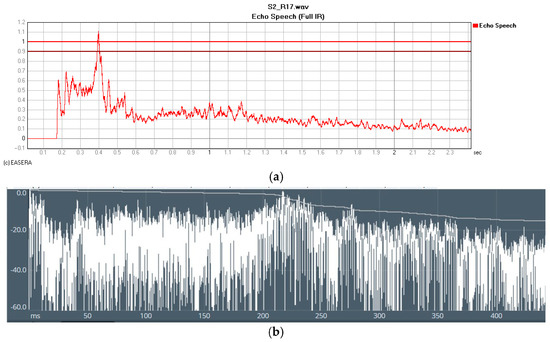
Figure 14.
(a) Speech echo parameter; (b) energy decay curve and Schroeder curve in the S2-R17 combination in the bullring of Las Ventas at broadband.
By using receivers in this bullring, the acoustic simulation confirms that echoes exist in all four receivers for source S1 in Table 7, both when the bullring is empty and is full of spectators. For the S2-R17 combination, there is only a risk of echo when the bullring is full, and in S3-R4, there is no echo, neither when the bullring is empty nor when the bullring is full. For the three receivers for sound source S4, there is only a risk of echo in the simulation with a full bullring, and, specifically in S4-R5, in neither empty nor full situations is there any risk of echo. This confirms the good agreement between the experimental results and the acoustic simulation results.
Regarding the situation when the sound source is located in the centre of the bull-ring S1 and the receiving microphone is located in Las Ventas arena (Table 8), it can be observed that there is a risk of echo in receivers E1 and E2 for both speech and music. The energy–time and Schroeder curves and the echo parameter values of these two receptors are presented in Figure 15. Figure 15a shows that E1 has a double echo for speech, and E2, Figure 15c, has a triple echo for speech. The EKspeech values and the times of all these reflections are indicated in Table 8.
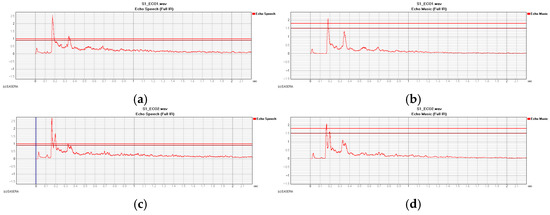

Figure 15.
Speech echo: (a) in S1-E1, (c) in S1-E2. Echo music: (b) in S1-E1, (d) in S1-E2. Energy decay curve and Schroeder curve: (e) in S1-E1, and (f) in S1-E2 combinations in the bullring of Las Ventas.
Furthermore, in the centre-symmetric source–receiver combinations S1-E4 and S1-E6, the strong reflection occurs at 49 ms, which is within the range that reinforces the direct sound. Hence, speech intelligibility is good, and no echo is present. In the centre-symmetric receivers E3 and E5, at distances of 15 m, a double echo can be observed for speech at the same time points.
The acoustic simulation using receivers confirms that with source S1, there is a risk of echo for speech at all six points of the ring, both when the bullring is empty and when it is completely full. For the other source positions, the situation is more irregular, with the echo risk predominating when the seating area is at full capacity. As for the maps obtained from the acoustic simulation, EKspeech shows that for S1, EK values > 1.5 appear in many areas of the ring, both without and with spectators. With the source at S2, areas of no echo can be observed in the ring, with a similar distribution both without and with spectators. At source position S5, a greater number of areas of the ring and grandstands with high EK values are found, and a greater risk of echo can be observed when the seating area is at full capacity. This increase in echo areas of the bullring with the presence of spectators in the grandstands and ring suggests that the increased absorption by spectators results in less masking of the strong reflections by the existing reverberation, see Figure 16, where it can be observed that the energy drops, although the peaks remain.
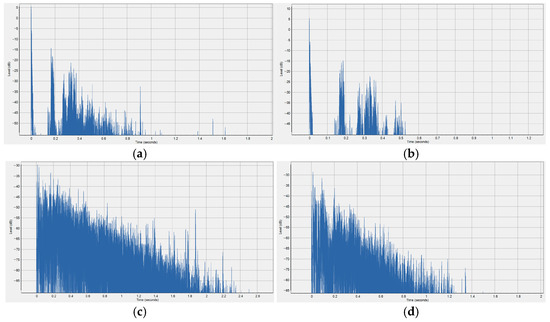
Figure 16.
Impulse responses in two source–receiver combinations of Las Ventas bullring (a) S1-E1 without the audience; (b) S1-E1 with the audience; (c) S1-R11 without the audience; and (d) S1-R11 with the audience.
4.2.4. Results in the Bullring of Campo Pequeno
In this bullring, in a first approximation of the 59 source–receiver combinations in the audience area with the oculus closed in the roof, there is a risk of echo for speech in only 2 combinations: S2-R9 and S4-R1. Moreover, in a first approximation of the 24 source–receiver combinations in the audience area with the oculus open, there is a risk of echo for speech in only 1 combination: S2-R9 (Table 9). Furthermore, according to the inspection of the time–energy curves for the combinations with the sound source on the side of the bullring S2, the strong reflection occurs within the reinforcement range of the direct sound and is not an echo. In the case of the combination for the sound source in the trumpet position, the strong reflection also occurs very close to 50 ms but is not of much interest given that it is a musical source and not a spoken source. It can therefore be observed that, in the spectator area for the performance taking place in the bullring, there are very few locations where echoes can be perceived for speech and in no case for music.

Table 9.
Echo and other acoustic parameters in the Lisbon bullring in the two roof configurations: closed oculus (CO) and partially open oculus (PO), in the audience area. In bold interpreted as an echo.
In a first approximation, of the 24 source–receiver combinations with both sound-source and receiver in the ring, 12 of which are with the roof oculus closed, there is a risk of echo in 8 combinations: S1-R1, S1-R2, S1-R7, S1-R8, and S1-R13; and in S2-R1, S2-R7, and S2-R8. Of the 12 source–receiver combinations with the source–receiver both in the ring with the roof oculus partially open, there is a risk of echo for speech in 7 combinations: S1-R1, S1-R7, S1-R8, and S1-R13; and in S2-R1, S2-R7, and S2-R8, see Table 10. A detailed analysis of the strong reflection times of the signals reveals that in the combinations of the source S2 with both the closed and partially open oculus, the strong reflections occur within the 50 ms time interval relative to the direct sound and are therefore not echoes but reflections that reinforce the direct sound. Consequently, an echo occurs only when the source is located in the centre of the bullring, S1.

Table 10.
Echo parameters and other acoustic parameters in the Lisbon bullring with source and receivers both in the ring and in the two roof configurations, closed oculus (CO) and partially open oculus (PO). In bold interpreted as an echo.
Furthermore, there are several receivers where a double echo can be observed for speech, specifically in S1-R1 with the oculus closed and in S1-R7 with either the oculus closed or partially open, and in S1-R13 for the two roof configurations. The intelligibility parameters of these receivers studied show that in this bullring, intelligibility in both the ring and the grandstands is Fair, improving to Good at short source–receiver distances.
In the Campo Pequeno bullring, in the two roof configurations, the patterns of impulse responses and curves of decay are very similar. Small differences are due to the absorption of the textile that makes up the mobile roof and to differences in the sessions of measurement, in both the receivers in the spectator areas and those located in the ring. Likewise, the similarity is observed in the values obtained in the echo parameters (EK) in Table 9 and Table 10.
4.2.5. Results in the Italica Amphitheatre
In the Italica amphitheatre, of the 39 source–receiver combinations measured in the audience area, there is, in a first approximation, a risk of echo for speech in 11 combinations: S1-R6, S2-R2, S2-R3, and S2-R4; and in S3-R2, S3-R6, S3-R7, S3-R8, S3-R10 and S3-R11; see Table 11. However, the study of the energy–time curves of the impulse response in receiver R6 of source S1, and of combination S3-R2 shows that the signal providing the Dietsch–Kraak parameter value for speech is actually noise and not a real echo. Likewise, for combinations involving S2, the strong reflection is very close to or within the limit of 50 ms, which is not an echo but a reinforcement of the direct sound. In fact, in all these source–receiver combinations, the acoustic intelligibility parameters present good or excellent values. Only in the case of the S3 source and the receivers that are located in the cavea between 40 and almost 50 m from the source do they present a real echo, with a decrease in the acoustic parameters linked to the intelligibility of speech.

Table 11.
Echo and other acoustic parameters in the Italica amphitheatre in the public area. In bold interpreted as an echo.
Of the 10 source–receiver combinations measured with both the source and receiver in the arena, a risk of speech echo is present in 6 combinations: in S2-R1, and S2-R5; and in S3-R1, S3-R5, S3-R16, and S3-R17, see Table 12. After analysing the decay curves of the impulse responses of these receivers, it is concluded that in all the receivers in the arena associated with source S2, these are strong early reflections that reinforce the direct sound. The same applies to all the receivers associated with source S3 except receiver R17, where a delayed signal appears at 95 ms after the arrival of the direct sound, which reduces the values of the intelligibility parameters, especially D50.

Table 12.
Echo and other acoustic parameters in the Italica amphitheatre with source and receiver both in the arena. In bold interpreted as an echo.
As a summary of Section 4.2 regarding the 347 impulse responses measured and processed to obtain the EKspeech and EKmusic parameters in the bullrings and amphitheatre, Table 5, Table 6, Table 7, Table 8, Table 9, Table 10, Table 11 and Table 12 of this section show the source–receiver combinations where EKspeech ≥ 1 and EKmusic ≥ 1.8. Of the 307 RIRs recorded in the audience area (39 in RMCR; 75 in RMCS; 71 in Las Ventas; 83 in Campo Pequeno in the two configurations of the roof (59 with the roof closed and 24 with the roof partially open); 39 in the Italica amphitheatre) excluding the musical source positions, it can be concluded that there is a risk of echo for speech in only 11 positions in total. These comprise one position in RMCS, with the sound source in the audience; five positions in Las Ventas, all five with the sound source in the ring of the bullring; and in five in the Italica amphitheatre, all with the sound source close to the focus of the arena ellipse. In none of the 307 recordings is there a risk of a disturbing echo for music. Furthermore, of the 40 experimental recordings when the source and the receiver are both in the arena (6 in Las Ventas; 24 in Campo Pequeno in the two configurations of the roof (12 in each configuration), and 10 in the Italica amphitheatre), a risk of echo for speech is obtained in the 6 positions of Las Ventas, 15 in Campo Pequeno (8 with CO and 7 with PO), and 1 in the Italica amphitheatre. There is also a risk of a disturbing echo for music in two positions of the six studied in Las Ventas bullring.
5. Conclusions
Roofless buildings are more likely to experience echoes than are closed venues. To study this acoustic phenomenon, this paper presents the results of the Dietsch–Kraak echo criterion parameter for speech and music in four bullrings on the Iberian Peninsula, each with a unique feature (Ronda without open-air grandstands, Seville with an ovoid-shaped arena, Las Ventas as the largest bullring in Spain, and Campo Pequeno with a movable roof), and a Roman amphitheatre from the time of the Hadrianic Hispania as a precursor to bullrings. The experimental results of the parameter and the association of the times and signals of strong reflections have been obtained from the impulse responses measured in the venues. In addition to processing the echo parameter calculations, those reflections with sufficient acoustic energy and delay relative to the direct sound to be interpreted as echoes are identified. This delay has also been analysed by using energy–time decay curves, which allow the determination of whether the delay is either a true echo or is so large and delayed that it can be associated with background noise. The results show that in neither the bullrings nor the amphitheatre is there a risk of echo for music in any of the public areas: the grandstands, covered galleries, and the cavea. Echoes for music have only been experimentally detected in two receivers in the bullring when the sound source is located in the centre of Las Ventas bullring. Likewise, there are few cases of echo in the public area for speech (of the 307 experimental recordings in the spectator area, only 11 recordings show a risk of echo for speech, see above), particularly in the grandstands of Las Ventas when the sound source is in the centre of the ring, due to the focusing of the sound from the great height of this bullring.
In many cases when the echo parameter indicated the possibility of echo problems, these problems were merely very late noise reflections rather than actual echoes, while in other cases, they were early reflections that reinforced the direct sound. Furthermore, in several cases, although echoes exist for the spoken word signal, they are from sound-source positions of a musical nature that occur in the bullrings: a music band, bugles and timpani, or trumpets.
In cases where both the sound source and the receiving microphone were located in the arena (Las Ventas, Campo Pequeno, and the Roman Amphitheatre according to experimental data, and Ronda and Las Ventas according to simulation data with the bullring empty), the results indicate that the arenas of the performing venues have large areas where echoes occur for speech and even for music, including when the ring is covered with a movable roof (Campo Pequeno, for example). These data are of interest in the case of theatrical and musical performances where both the sound source for speech or music and the audience are located in the arena. In the case when the performers and the public are both in the ring with the grandstands empty, then one echo mitigation strategy would be to delimit the performers and public area with rectangular absorbent walls.
The results of the acoustic simulation by receivers and from the colour maps of the speech echo parameter obtained by acoustic simulation throughout the bullring for each of the sound sources present (case of RMCR and Las Ventas) corroborate these conclusions, and that the areas of the ring and in the grandstands even worsen from the point of view of echo problems with the presence of the public throughout the bullring. This increase in echo areas of the bullrings, with the presence of spectators, in the grandstands and in the ring, suggests that the increased acoustic absorption by spectators results in a lower masking of the strong reflections from the reduced existing reverberation.
Author Contributions
Conceptualisation, S.G., M.M.-C., and M.G.; methodology, S.G., M.M.-C., and M.G.; software, S.G., M.M.-C., and M.G.; formal analysis, S.G., M.M.-C., and M.G.; writing—original draft preparation, S.G., M.M.-C., and M.G.; writing—review and editing, S.G., M.M.-C., and M.G. All authors have read and agreed to the published version of the manuscript.
Funding
This research received no external funding.
Institutional Review Board Statement
Not applicable.
Informed Consent Statement
Not applicable.
Data Availability Statement
The data presented in this study are available on request from the corresponding author. The data are not publicly available due to privacy restrictions.
Acknowledgments
The authors would like to thank the management and staff of all the bullrings studied herein for their kindness and support. Special thanks go to F.J. Nieves, J. Alayón, and the INTROMAC (Instituto Tecnológico de Rocas Ornamentales y Materiales de Construcción) for their collaboration in the field measurements and acoustic simulations. This article is a revised and expanded version of a paper entitled Echoes in Iberian bullrings, which was presented at Forum Acusticum Euronoise 2025, Malaga, Spain, 23–26 June 2025 [31].
Conflicts of Interest
The authors declare there to be no conflicts of interest.
Glossary
Albero: A calcarenite sedimentary rock of materials of marine origin with a characteristic ochre colour, albero is of Sevillian origin. This is the soil used in the bullring arenas.
Barrera: The wooden fence or barrier immediately next to the ring itself, which serves as a defence for the bullfighter over which the bullfighter can jump when pursued by the bull. Translation used herein: barrier.
Burladero: Short fences of the same height and construction as the barrier but placed parallel to said barrier within the ring itself, with a separation of approximately 35 cm from the main perimeter, so that the bullfighter can take refuge behind by entering from the side and the bull cannot enter.
Callejón: The circular passageway where the bullfighters, their assistants, and employees of the bullring take refuge, which runs between the main barrier and the fence delimiting the first-row seats. Translation used herein: passageway.
Picador: Bullfighter’s assistant on horseback who stabs the bull with his sword and performs in a precise zone within the ring.
Ruedo/Redondel: The circular area where the performance takes place. Translation used herein: ring or arena.
Tendido: Each of the sectors, generally numbered, into which the audience area of the bullring is divided depending on whether it is in the shade or direct sunlight, and whether it is close to or far from the centre of the arena. Each segment has access through an opening in the form of a short tunnel called a vomitorium. Translation used herein: segment, and segment of stalls.
References
- Kuttruff, H. Room Acoustics, 5th ed.; Taylor & Francis: New York, NY, USA, 2009. [Google Scholar]
- Cremer, L.; Müller, H. Principles and Applications of Room Acoustics; Applied Science Publisher: London, UK; New York, NY, USA, 1982; Volume 1. [Google Scholar]
- Haas, H. Ueber der Einfluss Eines Einfachechos auf die Hoersamkeit von Sprache (On the Influence of a Simple Echo on the Audibility of Speech). Doctoral Dissertation, University of Gottingen, Gottingen, Germany, 1949. [Google Scholar]
- Vera Guarinos, J.; Yebra-Calleja, M.; Calzado-Estepa, E.; Brocal-Fernández, F.; Miralles-García, A. Reflexiones sobre reflexiones, eco y reverberación. In Proceedings of the 45° Congreso Español Acústica, 8° Congreso Ibérico Acústica, Murcia, Spain, 29–31 October 2014. [Google Scholar]
- Cairoli, M. Ancient shapes for modern architectural and acoustic design: Large interiors formed by curved surfaces. Appl. Acoust. 2020, 170, 107497. [Google Scholar] [CrossRef]
- Cairoli, M. The architectural acoustic design for a multipurpose auditorium: Le Serre hall in the Villa Erba Convention Center. Appl. Acoust. 2021, 173, 107695. [Google Scholar] [CrossRef] [PubMed]
- Galindo, M.; Girón, S.; Cebrián, R. Acoustics of performance buildings in Hispania: The Roman Theatre and Amphitheatre of Segobriga, Spain. Appl. Acoust. 2020, 166, 107373. [Google Scholar] [CrossRef]
- Rindel, J.H. A note on meaningful acoustical parameters for open-air theatres. Acta Acust. United Acust. 2023, 7, 20. [Google Scholar] [CrossRef]
- Bolt, R.H.; Doak, P.E. A tentative criterion for the short-time transient response of auditoriums. J. Acoust. Soc. Am. 1950, 22, 507–509. [Google Scholar] [CrossRef]
- Dietsch, L.; Kraak, W. Ein objektives Kriterium zur Erfassung von Echostörungen bei Musik- und Sprachdarbietungen (An objective criterion for detecting echo interference in music and speech performances). Acustica 1986, 60, 205–216. [Google Scholar]
- Kürer, R. Zur Gewinnung von Eizahlkriterien bei Impulsmessungen in der Raumakustik (For obtaining criteria of impulse measurements in room acoustics). Acustica 1969, 21, 370. [Google Scholar]
- Lovstad, A.E. Evaluation of Objective Echo Criteria. Diploma Thesis, Norwegian University of Science and Technology, Department of Telecommunications, Trondheim, Noway, 16 June 2003. [Google Scholar]
- Wargert, S. A New Approach for Detecting Strong Reflections in Rooms. Master’s Dissertation, Division of Engineering Acoustics, Faculty of Engineering (LTH), Lund University, Lund, Sweden, April 2014. [Google Scholar]
- Jeong, C.H.; Jacobsen, F.; Brunskog, J. Thresholds for the slope ratio in determining transition time and quantifying diffuser performance in situ. J. Acoust. Soc. Am. 2012, 132, 1427–1435. [Google Scholar] [CrossRef] [PubMed]
- Briones-Ramos, J.J.; Bernabé-Sanchís, M. Simulación acústica en el diseño arquitectónico. In Proceedings of the 45° Congreso Español Acústica, 8° Congreso Ibérico Acústica, Murcia, Spain, 29–31 October 2014. [Google Scholar]
- ISO 3382-1:2009; Acoustics—Measurement of Room Acoustic Parameters—Part 1: Performance Spaces. International Organization for Standardization: Geneva, Switzerland, 2009.
- ISO 3382-2:2008; Acoustics—Measurement of Room Acoustic Parameters—Part 2: Reverberation Time in Ordinary Rooms. Organization for Standardization: Geneva, Switzerland, 2008.
- IRIS SOFTWARE. User’s Manual v1.2 Marshall Day Acoustics. 2018. Available online: https://www.iris.co.nz/ (accessed on 15 January 2025).
- Martín-Castizo, M.; Girón, S.; Galindo, M. Guía para la realización de mediciones acústicas en las plazas de toros (Guide for acoustic measurements in bullrings). In Proceedings of the Acustica2020, Faro, Portugal, 21–23 October 2020. [Google Scholar]
- Martín-Castizo, M.; Girón, S.; Galindo, M. A proposal for the acoustic characterization of circular bullrings. J. Acoust. Soc. Am. 2022, 152, 380–398. [Google Scholar] [CrossRef] [PubMed]
- EASERA. Electronic and Acoustic System Evaluation and Response Analysis (EASERA), version 1.1; AFMG Technologies GmbH: Berlin, Germany, 2025. Available online: https://www.afmg.eu/en/afmg-easera (accessed on 22 April 2025).
- Martín-Castizo, M.; Girón, S.; Galindo, M. Acoustic ambience and simulation of the bullring of Ronda (Spain). Buildings 2024, 14, 298. [Google Scholar] [CrossRef]
- Martín-Castizo, M.; Galindo, M.; Girón, S. El patrimonio acústico de la plaza de toros de la Real Maestranza de Caballería de Sevilla. In Proceedings of the BIAUS, ETS Arquitectura de Sevilla, Seville, Spain, 16–20 September 2024. [Google Scholar]
- Diaz-Recasens, G.; Vázquez-Consuegra, G. Las Plazas de Toros; Dirección General de Arquitectura y Vivienda: Sevilla, Spain; Consejería de Obras Públicas y Transportes: Sevilla, Spain, 2004; p. 364. [Google Scholar]
- Cossio, J.M. Los Toros. Tratado Técnico e Histórico; Espasa-Calpe, S. A.: Madrid, Spain, 1943; p. 1030. [Google Scholar]
- Girón, S.; Galindo, M.; Romero-Odero, J.A.; Alayón, J.; Nieves, F.J. Acoustic ambience of two Roman theatres in the Cartaginensis province of Hispania. Build. Environ. 2021, 193, 107653. [Google Scholar] [CrossRef]
- Barron, M. Interpretation of early decay time in concert auditoria. Acustica 1995, 81, 320–331. [Google Scholar]
- Fürjes, A.T.; Nagy, A.B. Tales of more than one thousand and one measurements (STI vs. room acoustic parameters—A study on extensive measurement data). Preprint 2020. [Google Scholar] [CrossRef]
- Onaga, H.; Furue, Y.; Ikeda, T. The disagreement between speech transmission index (STI) and speech intelligibility. Acoust. Sci. Technol. 2001, 22, 265–271. [Google Scholar] [CrossRef]
- ODEON Room Acoustics Software. User’s Manual, version 17; Technical University of Denmark: Lyngby, Denmark, 2021. Available online: https://www.odeon.dk/ (accessed on 18 February 2025).
- Echoes in Iberian Bullrings. In Proceedings of the Forum Acusticum Euronoise 2025, Malaga, Spain, 23–26 June 2025.
Disclaimer/Publisher’s Note: The statements, opinions and data contained in all publications are solely those of the individual author(s) and contributor(s) and not of MDPI and/or the editor(s). MDPI and/or the editor(s) disclaim responsibility for any injury to people or property resulting from any ideas, methods, instructions or products referred to in the content. |
© 2025 by the authors. Licensee MDPI, Basel, Switzerland. This article is an open access article distributed under the terms and conditions of the Creative Commons Attribution (CC BY) license (https://creativecommons.org/licenses/by/4.0/).